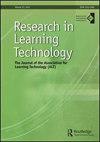作为沉浸式学习工具的廉价、易获取和虚拟体验:概念研究的证明
IF 1.2
Q2 EDUCATION & EDUCATIONAL RESEARCH
引用次数: 15
摘要
虚拟和增强现实技术在我们生存的众多环境中变得越来越普遍,包括教育环境。随着技术的进步,越来越多地接触到它的能力,人们对它的期望和依赖也越来越高。然而,使这项技术可用的大部分硬件(和一些软件)都是昂贵的,而且许多人无法获得。本文介绍了一种捕获和提供具有成本效益的虚拟现实体验的方法,在这里用作一种工具,为学生提供有关地质实验室样本的改进的辅助数据和上下文。介绍的方法利用谷歌纸板相机应用程序和谷歌纸板观看器。所创建的虚拟现实环境是一种微型沉浸式体验,可以提供给学生,也可以由学生收集以供自己使用。文章报告了20名参与者的研究结果,他们回答了一份问卷,概述了他们实施该方法的经验。他们的反应是积极的,强调了方法对任务的适用性,工具的易用性和技术的可及性。提出了该方法图像质量有待改进的地方。本文章由计算机程序翻译,如有差异,请以英文原文为准。
Cheap, accessible, and virtual experiences as tools for immersive study: a proof of concept study
Virtual and augmented reality technology is becoming more commonly available within a plethora of environments in which we exist, including educational environments. With advances in technology, and more exposure to its capabilities, there is a greater expectations and reliance on it. However, much of the hardware (and some of the software) which makes this technology usable is expensive and inaccessible to many. This article introduces a method for capturing and providing cost-effective virtual reality experiences, used here as a tool to give students improved accessory data and context regarding geological lab samples. The method introduced utilises the Google Cardboard camera app and Google Cardboard viewers. The virtual reality environment created is a mini-immersive experience that could be provided to students, or collected by students for their own use. The article reports results from a study of 20 participants who answered a questionnaire outlining their experiences of implementing the method. They responded positively, highlighting the applicability of the method to the task, the ease of use of tool and the accessibility of technology. Image quality of the method was raised as an area for improvement.
求助全文
通过发布文献求助,成功后即可免费获取论文全文。
去求助
来源期刊

Research in Learning Technology
EDUCATION & EDUCATIONAL RESEARCH-
CiteScore
6.50
自引率
0.00%
发文量
13
审稿时长
20 weeks
 求助内容:
求助内容: 应助结果提醒方式:
应助结果提醒方式:


